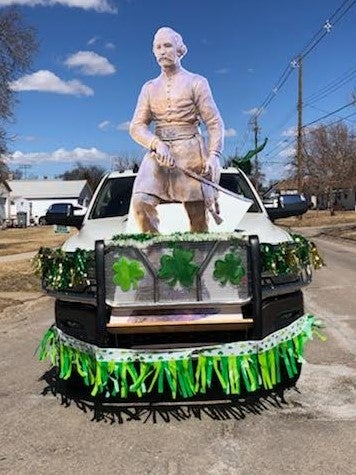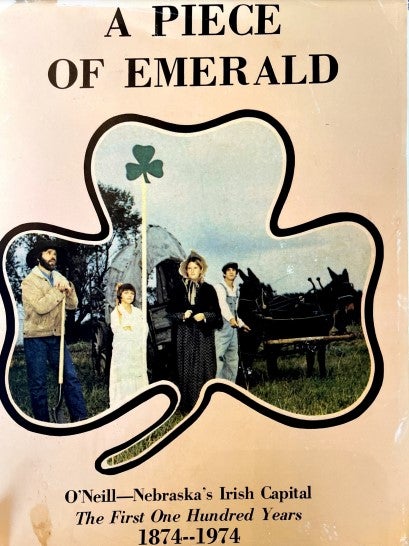Picking an Outfit for an Irish American Statue
Casey Brennan Donahue is a Master’s candidate in both the Department of History and the School of Foreign Service. He is currently a 2021-2022 Global Irish Fellow.

March was an ideal month for O’Neill, Nebraska to advertise its newest attraction. In October 2021, the state’s official “Irish Capital” unveiled a fifteen-foot bronze sculpture of town founder, US Civil War veteran, and militant Irish nationalist John O’Neill. While the statue is the product of a years-long effort by local leaders to raise funds and support, the uniform it wears reflects an ongoing discussion about the relationship between Irish nationalism, American patriotism, and Western settler heritage.
The bronze O’Neill dons a US Army Captain’s uniform. Sword half-drawn, he looks martial and composed—a fair depiction. While O’Neill never saw combat as a Captain, he earned a gallant reputation as First Lieutenant in the 5th Indiana Cavalry. Reports from Union comrades show him as over-proud and upright. He bodyguarded General Stoneman in Richmond, broke the momentum of “Morgan’s Raid” in Ohio, and killed at least seven rebels bare-handed. He was an “unusually dashing officer,” a gifted speaker in English and Irish, a template of Celtic-American masculinity.
But those Civil War exploits did not make him famous.
Between 1866 and 1871, O’Neill was the commander and later president of the Fenian Brotherhood, a “physical force” nationalist group that pursued a free republican Ireland through armed insurrection. In June 1866, he led some eight-hundred militiamen—mostly Union or Confederate veterans—into British Canadian territory. They landed at Fort Erie, demanded breakfast from Her Majesty’s local authority, announced the imminent liberation of Ireland, and seized the town of Ridgeway for two days. The Fenians’ (loosely articulated) strategy was to capture British colonial holdings and divert The Crown’s attention from a concurrent rebellion on Irish soil.
The “Battle of Ridgeway,” alternately remembered as “The Fenian Fiasco,” did not advance Irish freedom. Nor did the two other quixotic Canadian raids that O’Neill orchestrated over the next five years. But they earned him credibility in certain diaspora circles. At Ridgeway, he had given Irish rebels their only armed victory against British forces since the Rebellion of 1798. He made history as commander of the first military regiment to call itself the Irish Republican Army (IRA).
O’Neill leaned on those nationalist credentials when recruiting settlers for his “young Ireland on the virgin prairie.” His fame allowed him, between 1873 and 1878, to convince over one hundred Irish Americans to settle a township along the Elkhorn River that now bears his name. When he preached the benefits of Nebraskan homesteading to eastern Irish audiences, he employed sentimentalism, ethnic solidarity, and rebel anecdotes. Those who followed him West him eschewed his American titles, calling him “General,” his Fenian rank.
Nearly 150 years after his first settlers arrived, John O’Neill’s township immortalized him as an American Captain, not an Irish General. After all, it is illegal for US citizens to invade another country from American soil under the banner of a non-state revolutionary movement. Except for the case of the state-subsidized Confederate monuments that pockmark the South, governments don’t often pledge allegiance to US law while erecting statues to organizations bent on breaking the law.
O’Neill’s American uniform shows a community re-centering its founder’s contributions to the Union’s survival. “Growing up, I didn’t know anything about his Civil War history,” said Natalie Butterfield, Vice President of O’Neill’s Holt County Historical Society. “I thought that aspect of him is something the town can be proud of.”
But deciding against a Fenian statue was not as simple as assessing the legality of invading Canada. “We really wrestled with the question of portraying him in…his General’s uniform,” Natalie said. “To our knowledge, this is the only statue anywhere of John O’Neill in the world, so what to portray him in…there was a lot of talk.” Strong calls for an IRA portrayal came from outside Nebraska; reenactors and Irish republican history enthusiasts saw a chance to resurrect the legacy of a forgotten revolutionary.
Ultimately, those who erected the statue had optics to consider. Situated on the Holt County Courthouse Lawn, the monument is a joint project between local government and private volunteers. O’Neill may be Nebraska’s “Irish Capital,” but that title does not imply an official embrace of militant nationalism. “People got killed,” reflected Natalie on the Fenian Raids. “[British Canadians] lost their lives, for what many at the time saw as a folly.” By one historian’s estimate, eight Fenians and twelve Canadians died during the Battle of Ridgeway, with forty injured. “If somebody comes down from Canada and sees this—this great Fenian General… is that how John O’Neill is best remembered?”
The statue’s planners opted to minimize, not erase, the General’s revolutionary legacy. Peripheral nods to his Fenianism suggest that armed nationalism was one of many strategies O’Neill adopted in pursuit of his broader mission: “the amelioration of my [Irish] race.” The statue’s commemoration is scheduled for the Battle of Ridgeway’s anniversary. It also carries, in Natalie’s words, “a little secret.” On the top button of O’Neill’s left sleeve—the position nearest his heart—are the initials IRA. “It’s a replica of a button that was actually on a Fenian uniform.”
From Natalie’s telling, those three barely visible letters are a winking acknowledgment of an unavoidable fact: their founder was an Irish rebel. He wound up in Nebraska because he saw land ownership on the Great Plains as “the next best thing to giving Irish people their freedom at home.”
Monuments help communities tell themselves stories. By characterizing Nebraska as “the next best thing” to a liberated Ireland, O’Neill gave his town a narrative that lets Irish heritage—even nationalism—coexist with Western “pioneer” nostalgia. (One of the town’s most celebrated former residents is US senator Moses Kinkaid, whose eponymous 1904 Kinkaid Act opened the adjacent Sandhills Region to thousands of homesteaders).
In the mid-nineteenth century, Irish activists promoted westward migration in ways that resonated with a diaspora that had crafted its collective memory around themes of exile. The centuries-long history of US expansion is bloody and imperial; Irish Catholics were one of several marginalized groups to inherit lands that the federal government had coercively cleared of Native inhabitants. But John O’Neill’s four-year colonization of the Elkhorn River Valley was a bloodless affair—the only non-violent part of his legacy. His town’s foundational narrative is not a triumphalist tale of conquest and Manifest Destiny; it is about a wandering transatlantic people who found security on Nebraskan farmlands. A dedication during O’Neill’s 1974 centennial credited the General with bringing “a vision of hope and inspiration to his oppressed Irish countrymen” from “the ashes of a shattered dream.”
O’Neill’s bronze likeness tells a unique story of Irish Western Americanism. The statue, its location, and its surrounding discourse embrace the contradictions of a man whose legacies—violent and peaceful, American and Irish, immigrant and settler—are inextricably linked.

O’Neill’s anachronistic US uniform—fastened at the sleeve with Irish militancy—echoes the engraving on his tombstone: He fought with distinction for his adopted country and was ever ready to draw his sword for his native land.
O’Neill died of a stroke in 1878. Finding homes for immigrants was his life’s final act, and he performed it in civilian clothes. The world’s only John O’Neill statue stands in a Nebraskan settler town where he never drew his sword. This placement permits a new interpretation of the sculpture’s half-drawn weapon. Looking out over his “next best thing,” the General could easily be sheathing it.

